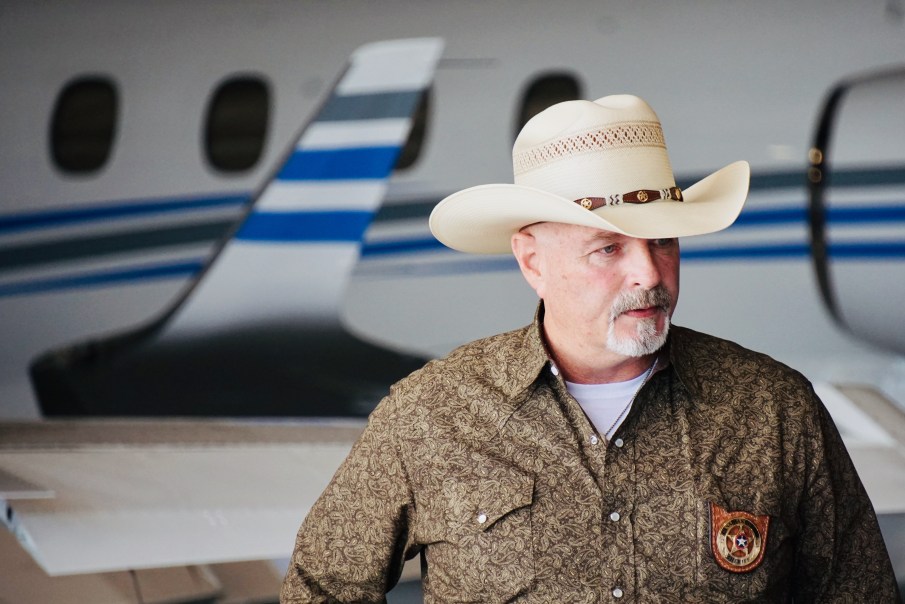
On a Sunday afternoon in late May, as protestors marched towards the Oklahoma City police department headquarters, many in the crowd turned their attention to the neighboring Oklahoma County Jail and the large black vehicle with “SPECIAL OPERATIONS” painted in yellow along the side.
Originally built to withstand explosive devices and rocket-propelled grenade attacks, the armored vehicle was now patrolling an American city, where peaceful protests against police brutality were being staged.
“It is strictly a defensive vehicle that our swat team members can use to … protect them from gunfire,” said Canadian County Sheriff Chris West, whose department operates two mine-resistant ambush protected vehicles, one of which was brought to the Oklahoma County jail during protests this summer.
The Canadian County Sheriff’s Office has two of 27 mine-resistant vehicles in Oklahoma that have been obtained through a federal program that funnels used military equipment to local law enforcement agencies.
But while these vehicles provide protection from gunfire and explosives, along with providing law enforcement with an intimidating display of force, they are just as often used for parades and community events, according to records obtained by The Frontier.

Since 2014, the Canadian County Sheriff’s Office has used its two mine resistant vehicles a combined 106 times, according to usage logs obtained by The Frontier through an open records request.
Forty-four percent of its use was for an official action, such as a “warrant service” or “tac team call out,” according to a usage log.
The rest of the time the vehicles were used at a public event, such as a parade, conducting a training exercise or out of repair.
On May 31, the day of a peaceful protest against police brutality that included a march from the state Capitol to downtown Oklahoma City, the usage log for Canadian County’s mine-resistant vehicles listed “riots” as the nature of the response.
The Bixby Police Department, which serves a city of 27,000, received a mine-resistant vehicle through the federal program in 2014. Since then, it has used it to respond to seven official calls, such as serving a “high risk warrant,” according to travel logs.
Above is a list of all military equipment received by Oklahoma law enforcement agencies through the 1033 program.
Twenty times it was used for a community event, including the Bixby Christmas Parade.
Bixby Police Chief Andy Choate told The Frontier he believed getting a chance to use the vehicle at community events is a great way to interact with the public.
“I see it as a positive,” Choate said.
In Bartlesville, the police department used its vehicle 22 times since 2014, according to the department’s deployment log.
On July 16, 2014, it was used to execute a search warrant for a suspect believed to have explosives and “armed posted guards,” according to the travel log.
On Oct. 9, 2018, the vehicle was also used to transport police officers to a firing range that required driving across a flooded bridge.
Two-thirds of the time the vehicle was used for community events, including an Easter egg hunt at the park.
However, most law enforcement agencies with a mine resistant vehicle told The Frontier they do not keep usage logs, once a requirement that President Donald Trump ended in 2017.
In Warr Acres, a city of 10,301 residents, Police Chief R.L. Patty said his department doesn’t keep usage logs, but told The Frontier it has been used three times since it was received in 2018, which includes two times this summer in response to protests in Oklahoma City.
Referred to as the LESO or 1033 program, the Department of Defense transfers excess federal property to state and local law enforcement agencies.
Since 2010, Oklahoma agencies have received more than $27.3 million worth of equipment, including firearms, trucks, aircraft and body armor.
The value of mine-resistant vehicles distributed to Oklahoma agencies is more than $20 million, according to federal records.

U.S. Sen. Jim Inhofe, R-Oklahoma, who has been active in increasing law enforcement access to the LESO program, called it a “no brainer.”
“It’s stuff that otherwise is going to go to West Africa or someplace else, and we don’t want that to happen when we have the need right here in Oklahoma,” Inhofe said.
The use of military equipment by local police has received increased attention in recent years as police respond to protests and demonstrations across the country.
“We’ve seen how militarized gear can sometimes give people a feeling like there’s an occupying force, as opposed to a force that’s part of the community that’s protecting them and serving them,” President Barack Obama said during a 2015 speech.
Following protests the previous year in Ferguson, Missouri, the Obama administration set restrictions on the use of some military equipment, including grenade launchers and bayonets.
But Trump has removed those restrictions.
“These restrictions went too far,” said Jeff Sessions, Trump’s former attorney general, announcing the reversal to a crowd of police officers in 2017. “We will not put superficial concerns above public safety.”

